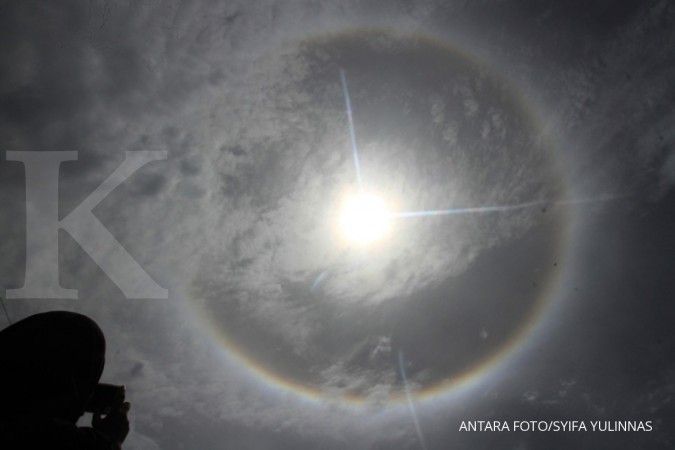KONTAN.CO.ID – JAKARTA. Earth will experience a space phenomenon called Aphelion on July 6, 2021. This was revealed by the National Aeronautics and Space Administration (Lapan).
Unlike previous astronomical events, the Aphelion phenomenon cannot be seen by the public, but the public can feel its impact.
Then, what is Aphelion and what impact does it have on Earth?
Earth at the farthest point from the Sun
Lapan Science and Space Center researcher Andi Pangerang explained, Aphelion is a phenomenon where the position of the Earth is at its furthest point from the Sun. This is because the Earth’s orbit is not completely a perfect circle, but an ellipse.
“Because it is an ellipse, every year the Earth is at its closest distance to the Sun (called Perihelion) which occurs every January, and is at its furthest distance from the Sun (which is referred to as Aphelion) which occurs every July,” Andi said when contacted by Kompas. com, Friday (2/7/2021).
Also Read: There will be an annular solar eclipse on June 10, which areas are crossed?
Andi added that the Aphelion phenomenon will occur on July 6, 2021 at 05.27 WIT or 06.27 WIT or 07.27 WIT.
Impact on Earth
In general, the Aphelion event did not have a significant impact on Earth. Because it occurs in the middle of the year, when this cycle enters the dry season in Indonesia, it makes cold temperatures in the mornings that have happened recently.
“This incident will last until August, and is a common thing in the dry season,” said Andi.
According to him, the cold temperature in the morning during the dry season is due to a little cloud cover. Thus, no heat from the Earth’s surface (which is absorbed from the Sun’s light and released at night) is reflected back to the Earth’s surface by clouds.
Given the current position of the Sun in the north, the air pressure in the northern hemisphere is lower than in the southern hemisphere, which experiences winter.
Therefore, the wind is blowing from the south to the north and currently the wind is blowing from the direction of Australia, which is experiencing winter.
The impact is the effect of decreasing temperatures, especially in Java, Bali and Nusa Tenggara, which are located south of the equator, which is currently happening.
Does not affect the heat of the Sun.
Meanwhile, the position of the Earth at a point from the Sun also does not affect the heat received by the Earth. This is because heat from the Sun is distributed throughout the Earth, with the most significant influence being caused by wind patterns.
“Considering that currently the wind is blowing from the south, which is winter, we will feel colder temperatures,” said Andi.
“Moreover, the visible diameter of the Sun will look slightly smaller than the average, which is about 15.73 arc minutes or a decrease of 1.68 percent,” he continued.
Also Read: There will be a Super Blood Moon lunar eclipse phenomenon tonight, check out the facts
Apsidal precision
Citing the official website of Lapan, Earth experiences apsidal precision motion, one of three precise motions caused by the shift of the apsidal point (namely Perihelion and Aphelion) to the first point of Aries.
This event causes the dates of Perihelion and Aphelion to shift one day after 58 years (with date variations of up to two days for two adjacent years).
It is estimated that 4,410 years from now (in 6430), Perihelion will coincide with the March equinox, while Aphelion will coincide with the September equinox.
Also Read: Want to see a total lunar eclipse today? Note the link
On the other hand, in the time span from the last decade to the next decade, the Aphelion and Perihelion phenomena occur about 13-15 times, after the solstice (solstice) of the Sun.
This phenomenon also affects the long duration of the four seasons on Earth. In 1248, Perihelion coincided with the solstice (then December 15 in the Julian Calendar), while Aphelion coincided with the solstice (then June 15 in the Julian calendar).
This causes the duration of astronomical autumn in the northern hemisphere (September equinox to December solstice) to equal the duration of astronomical winter in the northern hemisphere (from December solstice to March equinox).
Similarly, the duration of the astronomical spring in the northern hemisphere (from the March equinox to the June solstice) and the duration of the astronomical summer in the northern hemisphere (from the June solstice to the September equinox) is similar.
This article has been published on Kompas.com with the title “Aphelion Phenomenon July 6, Earth is at its furthest point from the sun, what is the impact?“
Author : Retia Kartika Dewi
Editor: Rendika Ferri Kurniawan
Editor: Barratut Taqiyyah Rafie
– – – .


